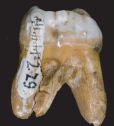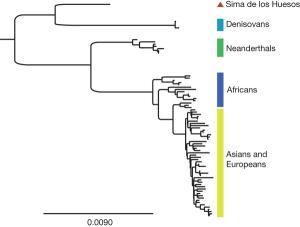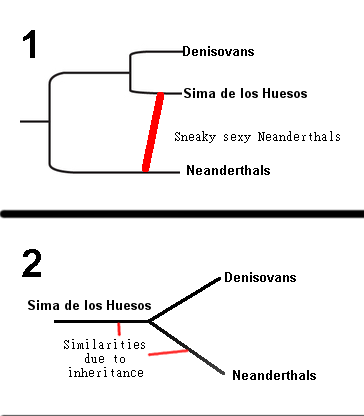Atapuerca is a series of Spanish caves that document almost a million years of human pre-history, from 1.2 million years ago to a mere 200,000 years ago. The caves see the appearance of the first humans to live in Western Europe1, which are replaced by Homo heidelbergensis2 who in turn gradually evolve Neanderthal-like traits3. DNA from one of these proto-Neanderthal fossils from the Sima de los Huesos cave was recently sequenced; except the results show that the individual was more closely related to the Denisovans than the Neanderthals4!

The Denisovan tooth
The Denisovans are an enigmatic branch of the human family, known only from the DNA obtained from a finger bone found in Denisova cave; which is over in eastern Eurasia, 7,500 km away from Atapuerca! We don’t know what they looked like, where they lived, how long their species lasted, what tools they made or pretty much anything really. All we do know is that they interbred with humans and Neanderthals, and that they split from humans ~800,000 years ago and Neanderthals some point between 600,000 – 170,000 years ago. Oh, and we also found one of their teeth. So we know what one of their molars looked like5.
But the Sima de los Huesos (SH) DNA isn’t actually Denisovan. It’s more closely related to the Denisovans than the Neanderthals, but is still very different from them. In fact its about as different from the Denisovans as we are from the Neanderthals; and the researchers calculated that the SH DNA diverged from them some point between 1 million – 400,000 years ago5. So the question isn’t so much “what are the Denisovans doing so from from Denisova?” but “what is this group of non-Neanderthals doing looking all Neanderthal-y?”

The new family tree of humans, Neanderthals and Denisovanns published in Nature
Before I deal with that question though a slight diversion is needed because this DNA is old. Super old. Like 400,000 years old, making it the oldest human DNA ever recovered by several hundred thousand years (as an interesting aside they also calculated the age of the bone based on the DNA and the result they got was 409,000 years). This impressive feat was made possible by newly developed extraction and preparation techniques, which were earlier tested by examining 300,000 year old cave bear DNA also from Sima de los Huesos6. However, despite this bear-based science only mitochondrial DNA (mtDNA) could be recovered from the human4. This is likely because each cell has more copies of mtDNA (because there are more mitochondria) than nuclear DNA (the stuff in the nucleus that builds the organism), so there’s a greater chance of at least some of it surviving. Unfortunately the amount of stuff mtDNA can tell us is relatively limited, since its only inherited down from the mother and is a bit weird.
So this means that we can’t answer most of the questions about what is going on with the Sima de los Huesos mtDNA. Currently there are 4 big possibilities, but without more DNA we have no way of knowing which one is right. Fortunately with our fancy new extraction techniques it seems likely we will be getting this data soon; so hopefully the mystery will be sorted out quite promptly.
Until it is though, we’re still left with these 4 possibles and no real way of deciding between them.

- The Sima de los Huesos group is relative of the Denisovans that lived in Western Europe. Their Neanderthal-esque features are coincidental, or perhaps the result of a bit of interbreeding (maybe only on the fathers side, which wouldn’t be detected in mtDNA)
- The Sima de los Huesos group is a remnant of the ancestors of Denisovans and Neanderthals (or maybe even the ancestor themselves). The Neanderthals inherited traits from this population, explaining why they’re physically similar.
- Its a quirk of mtDNA. Like how the Neanderthal DNA is much closer to Denisovan DNA than Neanderthal mtDNA is to Denisovan mtDNA. Or the fact Neanderthal mtDNA also underwent a bottleneck at one point5
- We’ve been oversimplifying the family trees of these guys. It wasn’t a straight line of proto-Neanderthals becoming Neanderthals, but a big mess of populations migrating, interbreeding, splitting and evolving in all sorts of confusing ways.
The researchers prefer the second explanation. John Hawks makes a nice argument for the fourth over on his blog (although if you follow that link I shall label you a heretic for reading another palaeoanthropology blog). Personally, I quite like number 3. Until we have more samples that rule out funky genetics I don’t want to go rewriting textbooks.
As I said, we can’t identify which of those is correct just yet (and there are a few more I’m omitting due to laziness). If more research is done I will keep you updated!
References
- Rodríguez, J., Burjachs, F., Cuenca-Bescós, G., García, N., Van der Made, J., Pérez González, A., … & Carbonell, E. (2011). One million years of cultural evolution in a stable environment at Atapuerca (Burgos, Spain). Quaternary Science Reviews, 30(11), 1396-1412.
- Mosquera, M., Ollé, A., & Rodríguez, X. P. (2012). From Atapuerca to Europe: Tracing the earliest peopling of Europe. Quaternary International.
- Stringer, C. (2012). The status of Homo heidelbergensis (Schoetensack 1908).Evolutionary Anthropology: Issues, News, and Reviews, 21(3), 101-107.
- Meyer, M., Fu, Q., Aximu-Petri, A., Glocke, I., Nickel, B., Arsuaga, J. L., … & Pääbo, S. (2013). A mitochondrial genome sequence of a hominin from Sima de los Huesos. Nature.
- Reich, D., Green, R. E., Kircher, M., Krause, J., Patterson, N., Durand, E. Y., … & Pääbo, S. (2010). Genetic history of an archaic hominin group from Denisova Cave in Siberia. Nature, 468(7327), 1053-1060.
- Dabney, J. et al. Complete mitochondrial genome sequence of a Middle Pleistocene cave bear reconstructed from ultrashort DNA fragments. Proc. Natl Acad. Sci. USA 110,15758–15763 (2013)

